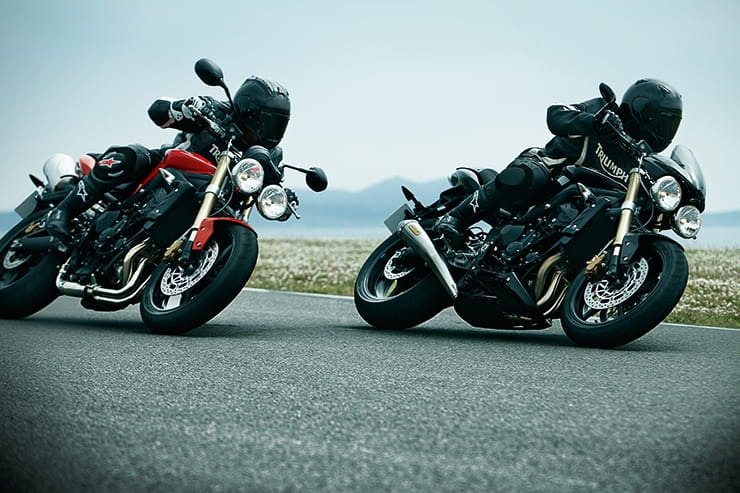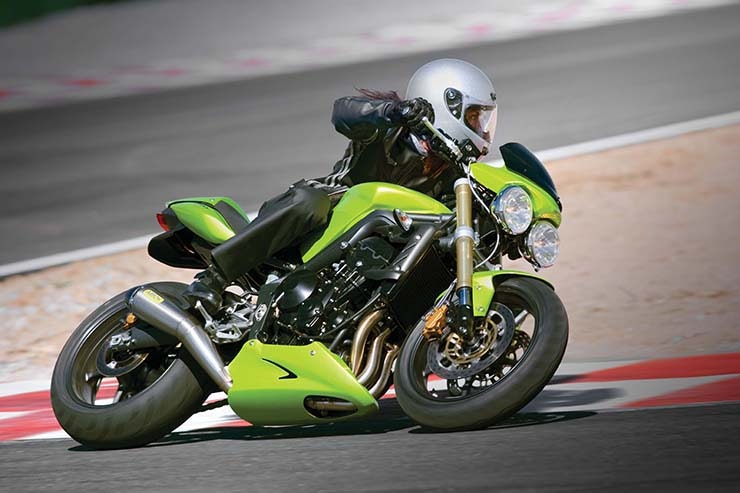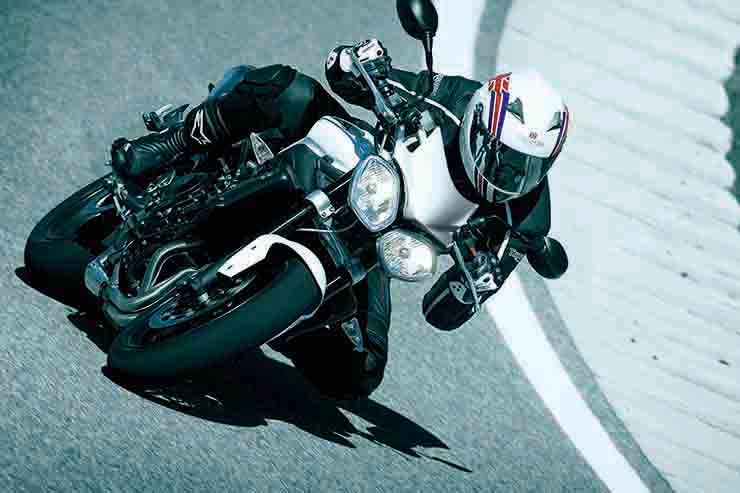Triumph Street Triple & R (2008 - 2012) - Review & Buying Guide
By Jon Urry
Massively experienced road tester
28.09.2022
Some used bikes require no introduction and certainly no sales pitch on why they make a great used buy – and the original Triumph Street Triple is one such bike. Unveiled in late 2007, the Street Triple took the Daytona 675 sportsbike as a base to create a naked bike that totally transformed the class. Amazing value, stunning performance and cool looks, the Street Triple had it all – including an R model that arrived a year later. Far from some budget ‘parts bin special’ the key to the Street Triple’s success (it was by a mile Triumph’s best-selling bike for many years) was the fact no corners had been cut. An absolute riot to ride, the Street Triple has that magic X-factor in abundance that elevates a good bike into a fabulous one. If you are in the market for a used naked middleweight that loves bends and guarantees grins (it’s pretty good at naughty stuff like wheelies...), look no further.
Triumph Street Triple and Street Triple R (2008-2012) Price
This is going to make you sob. When it was launched, the Street Triple cost just £5349 and a year later when the R emerged it only upped this to £6878. Yes, just over £5k for a Street Triple and less than £7k for the R, how on earth did Triumph make them at that price and not suffer a huge loss? Sadly for used buyers (although great news if you bought one back in the day and still have it!) a 2008 Street Triple will cost you around £2500-3000 with dealers generally asking in the region of £3500. If you want an R model, you need to budget closer to £4000. Considering we are talking bikes that are over 14 years old and hardly uncommon in the used market, that’s a lot of cash but proves just how popular the Street Triple was and still continues to be. The top end for the older ‘underseat pipe’ model is £5000-5500 for the stock model and £5500-6000 for an R – but it would have to be mint!
Power and torque
The Street Triple’s three-cylinder engine was its trump card and this format’s combination of punchy mid-range and a free-revving top end, not to mention a capacity advantage, saw it head and shoulders above its inline four rivals in terms of performance. Nowadays it does feel a touch lacking but that’s simply because the new 765cc version is so good. Ridden in isolation, the 675 version still ticks every box, it just needs to be worked a bit harder.
Engine, gearbox and exhaust
The triple engine is actually very solid and unlike the early Daytona motor, doesn’t suffer from burning oil issues due to it having different pistons. There are a few things to be wary of, however, with the most important being the cam chain tensioner. Start the bike from cold (and check it is properly cold by carefully touching the engine/exhausts) and listen out for a nasty rattle or any signs of smoke from the exhaust. A new cam chain tensioner is fairly cheap but if it is slack, there is always the possibility of damage having already happened within the engine. Next up on the check list is the service intervals, which are every 6000 miles with the valve clearances checked at 12,000. It’s not uncommon that the valve clearances will need altering, so check this service has been completed as skipping it can lead to major issues. Street Triples respond really well to balanced throttle bodies, so ask when this was last done. If they are out of balance the usually smooth triple can become a bit lumpy and aggressive on the throttle. If all seems well, and there are no warning lights on the dash, your next worry is the gearbox. Generally very robust, occasionally Street Triples can suffer from owner-induced abuse (poor gear changes without the clutch) and as a result will hop out of gear. Accelerate hard on a test ride and check the gears are all functioning properly. Finally, and this is a very important point, check the engine and frame numbers carefully for signs of tampering as the Street Triple is a hot target for thieves. Get an HPI check done to see if it has any hidden history and ensure the same key operates the ignition and fuel cap – if they are different assume the steering lock has been forced and the bike stolen at some point in its life.
Triumph Street Triple and Street Triple R (2008-2012) Economy
You can expect to record roughly 41mpg on a Street Triple, however this can drop quite dramatically should you thrash it. A good guide is 135-140 miles before the fuel light illuminates during ‘normal’ road riding.
Handling, suspension, chassis and weight
Although the base and R models have the same chassis, the higher-spec bike gains uprated fully-adjustable suspension from the Daytona. Do you need this added adjustability? Yes and no. Getting the stock forks rebuilt and re-valved by a professional to suit your riding style will see them perform just as well however you can’t change the damping should you wish to take the bike on track, which you can with the R’s units. A few owners look for R or Daytona model used forks for sale and fit them to the stock bike, which is easy to do but you need to be careful with spacers and also remember to buy the corresponding calipers! In general, it is better to rebuild the OE forks than stick in a new set that aren’t necessarily set correctly for the bike. When it comes to the shock, again the R has more adjustability when compared to the stock bike. As with the forks, you can stick a Daytona or R’s shock into the base bike but really, if you are considering this route, spend your money on a quality aftermarket unit instead as you can get it set to your individual requirements and it will be fully rebuildable, saving you cash in the long run. While we are on the suspension, always check the shock linkages aren’t seized and have lots of grease in them (they should be stripped every four years or so, although Triumph state every 12,000 miles) and that the head bearings aren’t worn, another area Triumph tended to skimp on the grease during assembly. With this all sorted, the Street Triple remains a brilliant handling bike that you can really go out and have a lot of fun on. It may have gained a few electronics and a change of styling over the years but the heart of it – namely its chassis – has remained virtually the same. And for a very good reason, it’s basically perfect!
Triumph Street Triple and Street Triple R (2008-2012) Brakes
Here we have the great irony of R models when compared to base bikes. The stock Street comes with two-piston sliding calipers as standard where the R gets four-piston radial units from the Daytona 675. What’s the difference? In terms of performance, you have to say very little on the road and they both have steel braided brake lines as standard. On track the stock model’s two-piston units are left a little bit lacking, but again, there is very little in it and in truth the R's calipers are mainly a visual upgrade. When buying used, the two piston calipers are prone to seizing on their sliders due to corrosion but as a rebuilt kit is less than £40 per side, this is hardly a massive drama and they are far easier to rebuild than the R’s units. Check the discs for wear, the calipers for any signs (or sounds) of sticking pistons and all should be well. If the braking feels a bit substandard, a fresh set of pads should be all that is required.
Comfort over distance and touring
The Street Triple is a naked bike that is based around a sportsbike’s chassis, so you have to expect it to feel a bit small and compact. While the bar and peg position isn’t too cramped, there isn’t a huge amount of room for movement and taller riders may struggle a bit when it comes to covering distances. The main issue, however, is wind blast and the twin headlights do very little to deflect any wind over the rider. A small screen helps a little bit but unless you are quite short, simply due to the Street’s diminutive size and the upright riding stance, you will always be exposed to the elements.
Rider aids and extra equipment / accessories
The Street Triple lacks any rider assists aside from a gear position and change indicator on its dash! ABS only arrived in the 2013 update, which is quite a different bike in comparison to the original model as it also features a new chassis and altered first gear ratio.
When it comes to accessories, there is a lot to choose from and while there are a few quality items, there is also a heck of a lot of nasty cheap parts to void. If you are a bit short in the leg, a lot of owners lower the bike. There are a few ways to do this but while you can fit new suspension linkages (cheap items are best avoided, go for a recognised brand), simply loosening and allowing the rear suspension’s joints to settle should drop the rear by about 25mm and you can then push the forks through the yokes by 10-15mm to retain the standard geometry and ensure its agile handing is unaltered. When buying used, always check for any signs of the bike being lowered – unless you actually want this!
Cosmetically, a lot of Street Triples come with belly pans, pillion seat covers, small screens or even brush guards, which are helpful for protecting both the bike and rider from the elements, and crash protection is also a good and common add-on. A few owners go for new brake levers, which are always best avoided unless you know they are from a genuine supplier and not cheap online knock-offs, and bar end mirrors are also fairly common.
To up the bike’s performance, replacement end cans are pretty standard and you have two options – replace the underseat pipes or retain them. Arguably heavy underseat pipes have a detrimental effect on the bike’s handling but that is all part of the original bike’s look and is why a few choose to keep them but swap them for lighter aftermarket cans. Other owners junk the underseat look altogether and fit a single ‘low boy’ exhaust, which makes the bike look like the updated 2013 model. The choice is yours. Triumph’s official supplier was Arrow, which are always preferred by Triumph purists. If the bike has cans fitted, check the ECU has received the ‘race’ update, which dealers have access to.
A few owners go a bit overboard when it comes to Street Triple extras and it is always best to avoid heavily modified bikes where possible. If you want the more modern ‘foxeye’ look instead of the round lights, get a 2012 final generation model, which had them as standard – much to the annoyance at the time of some purists!
Triumph Street Triple and Street Triple R (2008-2012) verdict
The Street Triple was a game-changing bike when it was launched in 2008 and remains a simply brilliant naked that although undeniably a touch small and compact for some is still excellent to ride. Fun, packing both mid-range grunt and a zippy top-end in its tripe engine and pleasingly bereft of annoying electronics, the first generation has much to love and remarkably little to avoid. Buy a good one and you will be left grinning from ear to ear after every ride – a truly great bike which like all good machines is annoyingly expensive because everyone knows this fact!
Three things we love about the Street Triple…
Sportsbike handling
Wonderful triple motor
Hooligan element – when requested!
Three things that we don’t…
Risk of theft
Build quality in a few areas
Annoyingly high price tag
Triumph Street Triple and Street Triple R (2008-2012) spec
Looking for motorbike insurance? Get a quote for this bike with Bennetts motorcycle insurance


